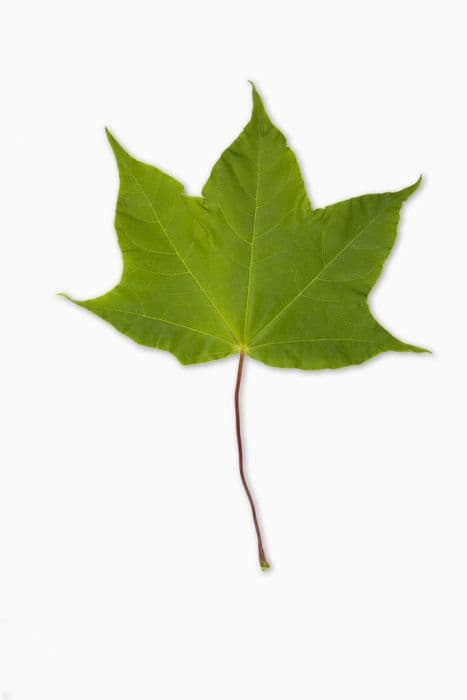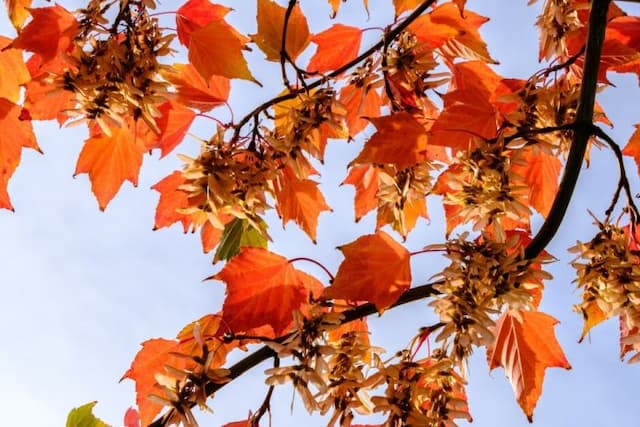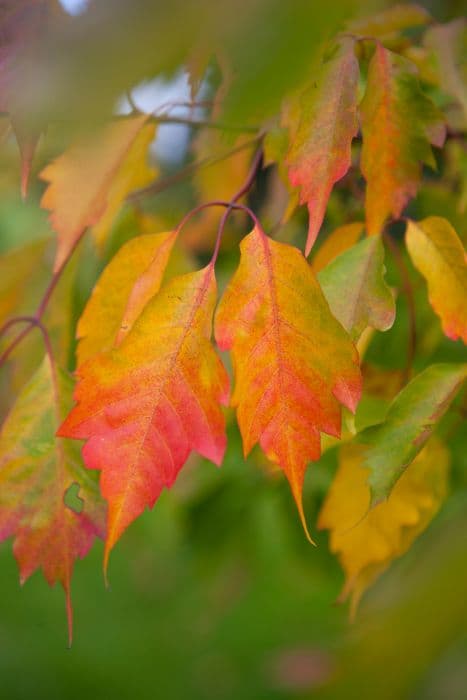Red Maple Acer rubrum 'October Glory'

ABOUT
'October Glory' is a cultivar of the red maple that is celebrated for its spectacular fall color. This plant has a canopy of lush, green leaves that are medium to dark green throughout the growing season. These leaves are typically three to five lobed, with a shape resembling that of a classic maple leaf. As the name 'October Glory' suggests, this plant puts on a vivid show in autumn when the foliage transforms into a brilliant display of vivid reds and sometimes orange tones, reminiscent of a quintessential fall landscape. This exceptional fall color is one of the main reasons why the plant is so popular, as it provides a burst of color when many other plants are starting to decline at the end of the growing season. Beyond its colorful foliage, the red maple 'October Glory' also produces small, attractive red flowers that can be seen in early spring before the leaves emerge. These flowers are followed by the production of samaras, commonly known as 'helicopter' seeds due to their unique shape that allows them to spin as they fall to the ground, which aids in seed dispersal. The bark of the 'October Glory' is smooth and gray when young and becomes more ridged with age. The overall appearance of the plant is well-rounded and symmetrical, giving it a stately and aesthetically pleasing form that is often sought after for landscaping purposes. The foliage, vibrant seasonal colors, and pleasant structure make 'October Glory' an attractive plant throughout the year.
About this plant
 Names
NamesFamily
Sapindaceae.
Synonyms
October Glory Red Maple, Common Red Maple, Scarlet Maple, Swamp Maple, Soft Maple, Water Maple.
Common names
Acer rubrum 'October Glory'.
 Toxicity
ToxicityTo humans
Red maple, including the 'October Glory' cultivar, is generally not considered toxic to humans. There are no well-documented cases of poisoning from ingesting parts of this plant. As a precaution, it's still advisable not to consume any parts of ornamental plants without proper knowledge or guidance.
To pets
Red maple can be toxic to pets, especially horses. Ingesting leaves, especially wilted or dried ones, can cause red blood cell damage in horses, leading to symptoms such as jaundice, dark brown urine, increased heart and breathing rates, and potentially even death if not treated. Other pets like dogs and cats are less likely to be affected, but it is still best to prevent all pets from ingesting parts of this plant.
 Characteristics
CharacteristicsLife cycle
Perennials
Foliage type
Deciduous
Color of leaves
Green
Flower color
Red
Height
40 feet (12 meters)
Spread
30 feet (9 meters)
Plant type
Tree
Hardiness zones
4-9
Native area
North America
Benefits
 General Benefits
General Benefits- Ornamental Value: The Red Maple 'October Glory' is renowned for its vibrant red fall foliage which adds significant aesthetic appeal to landscapes.
- Shade Provision: Its broad canopy provides ample shade in the summer, making it an excellent choice for parks, gardens, and as a street tree.
- Favorable Habitat: The tree serves as a habitat for various wildlife species, offering food in the form of seeds and a structure for nesting.
- Adaptability: 'October Glory' is adaptable to a range of soil types and conditions, making it suitable for various landscapes.
- Easy Maintenance: This specific cultivar requires minimal pruning and maintenance once established, which is convenient for property owners.
- Erosion Control: Its root system helps stabilize the soil, reducing erosion on slopes and in areas prone to heavy rainfall.
- Enhanced Biodiversity: Planting 'October Glory' contributes to an increase in plant diversity within the ecosystem.
- Longevity: The Red Maple is a long-lived species that can provide benefits for many decades when properly cared for.
- Seasonal Interest: In addition to its fall color, the tree offers year-round interest with its spring flowers and attractive bark in winter.
 Medical Properties
Medical PropertiesThis plant is not used for medical purposes.
 Air-purifying Qualities
Air-purifying QualitiesThis plant is not specifically known for air purifying qualities.
 Other Uses
Other Uses- Acer rubrum 'October Glory' wood can be utilized in woodworking projects such as carving or making small wooden items like bowls, due to its fine grain and workability.
- Red maple trees are sometimes used in bonsai culture, where they are meticulously pruned and cared for to create miniature landscapes.
- The sap of the red maple can be used in the production of maple syrup, though it is less sweet compared to the sap of the sugar maple.
- Fallen red maple leaves can be collected and used as a natural mulch in gardens, providing insulation and nutrients as they decompose.
- Fiber from the red maple can be processed and potentially used in the creation of paper or as a textile dyeing agent due to its tannin content.
- The tree's bark can be employed in crafting activities, like making rustic outdoor signs or as a canvas for bark art.
- Dried branches and twigs of the red maple can be utilized for kindling or as decorative elements in floral arrangements or wreaths.
- Red maple wood chips are sometimes added to grills or smokers to impart a sweet, smoky flavor to meats and other dishes.
- Red maple can be planted in large containers and used to create moveable screens or privacy barriers on patios and decks.
- The color-changing leaves can also serve as an educational tool to demonstrate the seasonal changes and chlorophyll breakdown in plants.
Interesting Facts
 Feng Shui
Feng ShuiThe Red Maple is not used in Feng Shui practice.
 Zodiac Sign Compitability
Zodiac Sign CompitabilityThe Red Maple is not used in astrology practice.
 Plant Symbolism
Plant Symbolism- Life and Vitality: The Acer rubrum, commonly known as the Red Maple, is known for its vibrant red foliage. This vibrant coloration symbolizes life and vitality, reflecting the tree’s vigorous growth and adaptability.
- Transition and Change: As a species that dramatically changes color with the seasons, the Red Maple is often seen as a symbol of transition and change, reminding us of the constant flux in life and nature.
- Canadian Culture: The maple leaf is famously associated with Canada, and the Red Maple serves as a cultural emblem representing Canadian identity and values such as peace and tolerance.
- Balance and Adaptability: Red Maples flourish in a wide range of soil types and conditions, symbolizing balance and the ability to adapt to various situations in life.
- Endurance and Strength: With its sturdy growth and resilience, the Red Maple exemplifies endurance and strength, capable of withstanding storms and other natural challenges.
 Water
WaterThe October Glory Maple should be watered deeply once a week, providing 15-20 gallons per watering for young trees and increasing the amount as the tree matures, ensuring the soil is thoroughly soaked. During hot, dry periods, increase the frequency to twice a week. Taper watering in the late fall as the tree prepares for dormancy, and during winter months, provide supplemental water only if there's a pronounced drought.
 Light
LightThe October Glory Maple thrives in full sun to partial shade. Ensure that it receives at least 6 hours of direct sunlight every day, preferably during the morning to early afternoon hours. Avoid deeply shaded areas as this can impact the tree's growth and autumn coloration.
 Temperature
TemperatureThe October Glory Maple is hardy and can endure temperatures as low as -40°F and as high as 90°F. It prefers moderate conditions where temperatures are consistently between 60°F and 80°F. It is adaptable but may experience stress or damage at temperature extremes.
 Pruning
PruningPrune the October Glory Maple during late winter or early spring before new growth starts to remove any dead, damaged, or diseased branches. Light pruning can also be done to shape the tree or maintain a desired size, but heavy pruning should be avoided. Pruning is generally needed every 3 to 5 years, depending on the tree's growth.
 Cleaning
CleaningAs needed
 Soil
SoilRed Maple 'October Glory' thrives in well-draining, slightly acidic soil with a pH of 6.0 to 6.5. A mix incorporating loamy soil, compost, and a small amount of sand or perlite is ideal, promoting healthy root development and adequate moisture retention.
 Repotting
RepottingRed Maple 'October Glory' does not require frequent repotting as it is a large tree best grown outdoors. If grown in a container, it should be repotted every 3-5 years into a larger pot to accommodate root growth.
 Humidity & Misting
Humidity & MistingRed Maple 'October Glory' is adaptable and does not require specific humidity conditions; it fares well in average outdoor humidity levels.
 Suitable locations
Suitable locationsIndoor
'October Glory' Red Maple isn't suitable for indoor growing.
Outdoor
Plant 'October Glory' in sun, give space, water well.
Hardiness zone
4-9 USDA.
 Life cycle
Life cycleThe October Glory Red Maple begins its life as a seed which germinates in late spring after being dispersed by wind. The young sapling emerges and will undergo a period of rapid growth over several years, establishing a fibrous root system and a strong trunk. During its juvenile stage, the tree experiences increased branching and leaf development, eventually maturing to produce its characteristic brilliant red fall foliage. After approximately 10 years, the tree reaches reproductive maturity and starts to flower in early spring, with small red flowers that give way to samaras, or winged seeds. This cycle of flowering and seed production continues annually throughout the tree's life, which can span up to 80-100 years under ideal conditions. As it matures, the October Glory Red Maple may undergo periods of slowed growth, but remains a vital part of the ecosystem by providing habitat and food for wildlife until it eventually reaches senescence and dies, completing its lifecycle.
 Propogation
PropogationPropogation time
Late winter-early spring
The most popular method of propagation for the Red Maple 'October Glory' is through softwood cuttings taken during late spring or early summer, when new growth is mature enough yet still tender. Gardeners typically select healthy, non-flowering shoots from the current year's growth and cut them into segments about 4-6 inches (10-15 cm) long, making sure each cutting has at least two sets of leaves. The bottom set of leaves is removed, and the cut end is often dipped into a rooting hormone to encourage root development. The prepared cuttings are then inserted into a well-draining potting mix, ensuring at least one set of leaves remains above the surface. The cutting should be kept in a humid environment with indirect light until roots have developed, which can be checked by a gentle tug on the cutting after a few weeks to feel for resistance, indicating root growth.









